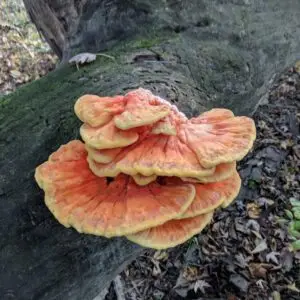The Ultimate Guide to Growing Chicken of the Woods Mushroom (Laetiporus sulphureus)
Guide to Growing Chicken of the Woods Mushroom (Laetiporus sulphureus) is one of the most unique and sought-after wild edible mushrooms. Known for its bright orange-yellow coloring and meaty texture, this shelf-like polypore is a favorite among foragers and chefs alike. Aptly named for its chicken-like flavor and texture, it’s often used as a meat substitute in vegetarian and vegan cooking.

Although traditionally harvested in the wild, growing Chicken of the Woods mushroom is possible with the right techniques, patience, and environmental setup. This in-depth guide covers everything you need to know—from inoculating logs to harvesting your first flush—and includes trusted resources like The Spore Depot to get you started.
What Is Chicken of the Woods (Laetiporus sulphureus)?
Laetiporus sulphureus, or Chicken of the Woods, is a wood-decaying bracket fungus that grows primarily on oak, chestnut, and other hardwoods, though some species may also colonize conifers. It forms large, fan-shaped clusters of overlapping shelves with bright yellow pores and an orange surface. This mushroom lacks gills and reproduces through pores underneath its cap.
It is a choice edible when harvested young and properly cooked. Beyond its culinary value, it also contains compounds that may have antimicrobial and antioxidant properties, adding to its appeal in the world of functional mushrooms. Guide to Growing Chicken of the Woods Mushroom.
Why Grow Chicken of the Woods Mushrooms?
✔ High Culinary Demand – Popular in gourmet kitchens for its meat-like texture
✔ Sustainable – Reduces dependence on wild harvesting
✔ Profitable – Commands high prices at farmers markets and specialty stores
✔ Low Maintenance Once Established – Especially in outdoor settings
✔ Visually Stunning – Adds aesthetic value to mushroom gardens
Challenges of Growing Chicken of the Woods Mushrooms
Before diving in, it’s important to note that growing Chicken of the Woods mushroom can be more challenging than other species like oyster or shiitake mushrooms. It has a longer colonization time and prefers specific wood types and environmental triggers.
However, with the right technique and a bit of patience, it’s entirely possible to cultivate this mushroom on logs or sawdust blocks.
Methods for Growing Chicken of the Woods Mushroom
- Log Cultivation (Most Common & Natural Method)
- Sawdust Block Cultivation (Less Common, Indoor Control)
Method 1: Growing Chicken of the Woods on Logs
Step 1: Selecting the Right Logs
Laetiporus sulphureus naturally grows on oak, chestnut, cherry, and beech. Avoid using conifers unless you’re working with a species adapted to softwood. Guide to Growing Chicken of the Woods Mushroom!
🪵 Ideal Log Specs:
- Diameter: 4–8 inches
- Length: 2–4 feet
- Freshly cut logs (2–3 weeks old) are best
- Cut during dormant season (late fall–early spring)
Step 2: Inoculating Logs with Spawn
You’ll need Chicken of the Woods plug or sawdust spawn, which can be purchased from The Spore Depot.
🧰 Tools Required:
- Drill with 5/16” bit
- Plug or sawdust spawn
- Mallet or inoculation tool
- Cheese wax or beeswax for sealing
- Heat source for melting wax
🔧 Inoculation Process:
- Drill holes 1.25” deep in a diamond pattern, spaced 4–6 inches apart.
- Insert spawn into holes using a mallet or inoculator.
- Seal each hole with melted wax to prevent contamination and moisture loss.
- Label logs with inoculation date and mushroom type.
Step 3: Incubation Period for Guide to Growing Chicken of the Woods Mushroom
📍 Environment: Stack logs in a shaded, humid area with good airflow—ideal for outdoor woodland setups.
🕒 Colonization Time: 12–24 months
💧 Keep logs moist by watering or soaking every 4–6 weeks during dry periods.
🛑 Patience is key—Chicken of the Woods mushrooms are slow to establish but can fruit for several years once they do.
Step 4: Fruiting and Harvesting
Fruiting typically occurs in spring or fall after the first major rain following a dry period.
To encourage fruiting:
- Soak logs in cold, non-chlorinated water for 24–48 hours
- Return them to the fruiting area with proper shade and humidity
🍄 Harvest young, tender brackets before they become leathery. Use a clean knife and avoid pulling them off the log. Guide to Growing Chicken of the Woods Mushroom.
Method 2: Growing Chicken of the Woods Mushrooms on Sawdust Blocks
This method is more experimental and best suited for indoor growers with sterile conditions.
Substrate Formula:
- 80% hardwood sawdust
- 20% wheat bran
- Adjust to 60–65% moisture
🧪 Sterilize using an autoclave or pressure cooker at 15 PSI for 90–120 minutes.
Once cooled, inoculate with grain or sawdust spawn and allow to colonize in a sterile space.
📍 Fruiting Conditions:
- Temp: 55–70°F (13–21°C)
- Humidity: 85–95%
- Light: Indirect light (12 hours/day)
- Air exchange: 2–4 times/day
Blocks may take 6–12 months to fruit and are generally less productive than logs. Guide to Growing Chicken of the Woods Mushroom.
🔗 For specialty spawn and substrate blocks, visit The Spore Depot
Caring for Your Chicken of the Woods Mushroom Grow
Key Considerations:
- Monitor for pests (slugs, beetles) during fruiting
- Maintain consistent moisture for logs
- Avoid stacking logs too tightly (airflow is essential)
- Do not harvest old, rubbery, or dry fruiting bodies—they’re unpleasant to eat and can cause digestive upset
Common Issues When Growing Chicken of the Woods Mushroom
❌ No Fruiting
✔ Logs may still be colonizing—wait up to 2 years
✔ Increase soaking frequency during fruiting seasons
✔ Check for improper wood type or contamination
❌ Mushrooms Too Tough or Bitter
✔ Harvest younger specimens
✔ Avoid overexposure to direct sunlight
❌ Contamination in Indoor Grows
✔ Use sterile techniques
✔ Ensure proper substrate hydration and sterilization
Harvesting and Using Chicken of the Woods Mushrooms
🌱 When to Harvest:
- Caps are vibrant orange/yellow
- Flesh is tender and moist
- Brackets are 2–8 inches wide
🔪 Use a knife to cleanly slice from the base. Avoid overharvesting to allow regrowth in subsequent flushes.
🍽 Cooking Tips:
- Always cook thoroughly before eating
- Great in stir-fries, fried “chicken” style, tacos, or creamy pasta
- Freezes well when sautéed and portioned
Storing and Preserving Your Harvest
📦 Storage:
- Fresh: 5–7 days in a paper bag in the fridge
- Cooked: Up to 6 months in the freezer
- Dehydrated: Use for soups and stews after rehydrating
Where to Buy Chicken of the Woods Mushroom Spawn and Supplies
🛒 Trusted Sources:
- ✅ The Spore Depot – High-quality Laetiporus sulphureus spawn, plug kits, and growing advice
- Field & Forest Products – Commercial tools and strains
Authoritative Resources for Learning More
📘 Books & Articles:
- Mycelium Running by Paul Stamets
- Growing Gourmet and Medicinal Mushrooms by Paul Stamets
- Cornell Small Farms Program – Mushroom Cultivation
- The Spore Depot Blog – Cultivation tips and updates
Conclusion: Growing Chicken of the Woods Mushroom Successfully
Growing Chicken of the Woods mushroom may take more time and patience than other varieties, but the payoff is enormous—delicious, protein-rich mushrooms with a long shelf life and excellent market demand.
Whether you choose to inoculate logs in your backyard or explore indoor cultivation with sawdust blocks, starting with reliable spawn from vendors like The Spore Depot will set you up for success. With care, moisture, and time, you’ll be rewarded with bold, beautiful clusters of Laetiporus sulphureus that are as tasty as they are striking.
#ChickenOfTheWoods #LaetiporusSulphureus #GrowingChickenOfTheWoodsMushroom #MushroomCultivation #TheSporeDepot #FunctionalMushrooms #FungiFarming #EdibleMushrooms





